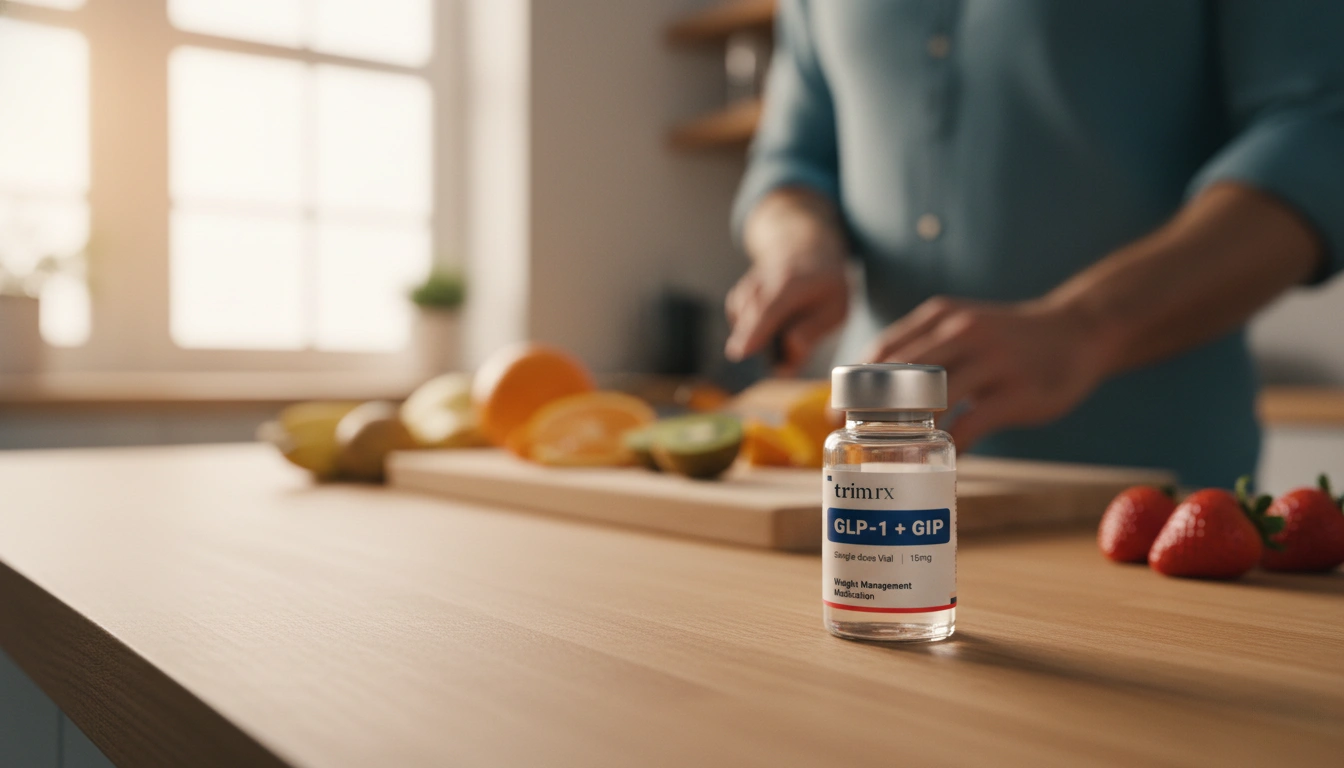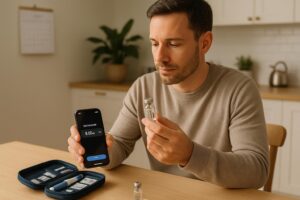Where Do You Inject GLP-1? A Comprehensive Guide to Safe and Effective Injections

Introduction
Did you know that nearly 42% of adults in the United States are classified as obese? This staggering statistic highlights the growing need for effective weight management solutions. One of the most promising developments in this area is the introduction of GLP-1 (glucagon-like peptide-1) medications, which have gained significant attention for their potential role in weight loss and diabetes management. As more individuals turn to these therapies, understanding where to inject GLP-1 medications becomes crucial for maximizing their benefits and ensuring a safe experience.
At TrimRx, we are dedicated to providing personalized, medically supervised weight loss solutions. Our commitment to merging cutting-edge telehealth innovations with effective weight loss strategies allows us to support individuals on their journeys to healthier lifestyles. In this blog post, we will explore the various injection sites for GLP-1 medications, best practices for administering injections, and common concerns associated with the process. By the end of this article, you will have a clear understanding of how to safely and effectively inject your GLP-1 medication to enhance your weight loss journey.
We’ll dive into the following key areas:
- Understanding GLP-1 Medications: What they are and how they work.
- Recommended Injection Sites: Where to inject GLP-1 medications for optimal absorption.
- Best Practices for Injection: Step-by-step guidance for a comfortable experience.
- Common Mistakes to Avoid: Tips for ensuring safety and effectiveness.
- Managing Injection Site Reactions: What to expect and how to respond.
- Conclusion and Call to Action: Encouraging readers to take control of their weight loss journey.
Let’s embark on this informative journey together, ensuring that you feel empowered and confident in your use of GLP-1 medications.
Understanding GLP-1 Medications
GLP-1 medications are a class of drugs that mimic the action of the GLP-1 hormone, which plays a crucial role in regulating appetite and glucose metabolism. These medications, such as Semaglutide and Tirzepatide, are designed to help individuals manage their weight and improve their health. The FDA has approved several GLP-1 medications for use in weight management, including brand names like Wegovy and Ozempic.
These medications work by:
- Stimulating insulin secretion: GLP-1 medications prompt the pancreas to release insulin in response to elevated blood sugar levels, which helps maintain normal blood sugar control.
- Suppressing appetite: By acting on brain receptors, GLP-1 medications reduce feelings of hunger, making it easier for individuals to adhere to dietary restrictions and ultimately lose weight.
- Slowing gastric emptying: These medications slow down how quickly food leaves the stomach, leading to prolonged feelings of fullness after eating.
As we explore the specifics of administering these medications, remember that TrimRx is here to provide personalized support through our medically supervised programs. We encourage you to take our free assessment quiz to see if you qualify for our prescription weight loss medications. Start your journey today!
Recommended Injection Sites
When administering GLP-1 medications, it is essential to choose the right injection site to ensure effective absorption and minimize discomfort. Here are the recommended injection sites:
1. Abdomen
The abdomen is often the preferred site for injections because of its ease of access and relatively low discomfort levels. When injecting into the abdomen, follow these guidelines:
- Avoid the belly button: Always inject at least two inches away from your belly button to minimize discomfort and reduce the risk of irritation.
- Rotate sites: Regularly change the specific area within the abdomen where you inject to prevent skin irritation and ensure consistent absorption.
2. Thigh
The thigh is another viable option for GLP-1 injections. Here’s how to use this site effectively:
- Outer thigh: Inject into the outer thigh area, which typically has more fat and can be less painful.
- Accessibility: This site is great for those who may need assistance with their injections, as it can be easier for someone else to help.
3. Upper Arm
While the upper arm is less commonly used, it can be a suitable site for injections, especially for individuals comfortable with administering their injections in this area. Consider the following:
- Assistance may be needed: Injecting into the upper arm may require help from another person for precise placement.
- Fatty tissue: Ensure you are injecting into a fatty area to promote effective absorption.
Injection Site Rotation
Rotating injection sites is crucial for preventing complications such as scarring and lipodystrophy (changes in fatty tissue). By alternating between the abdomen, thigh, and upper arm, you can minimize the risk of irritation and ensure consistent medication absorption.
Best Practices for Injection
Administering GLP-1 medications can be straightforward when you follow the right steps. Here’s a step-by-step guide to help you perform your injections safely and comfortably:
Step 1: Gather Your Supplies
Before you begin, make sure you have the following items ready:
- Your GLP-1 medication (pen or vial)
- Insulin syringes (if using a vial)
- Alcohol swabs for disinfecting the skin
- A sharps container for safe needle disposal
Step 2: Wash Your Hands
Start by thoroughly washing your hands with soap and water to minimize the risk of introducing bacteria at the injection site.
Step 3: Prepare the Injection Pen or Vial
- If using a pen, follow the manufacturer’s instructions to prime the pen if necessary.
- If using a vial, clean the rubber cap with an alcohol swab before drawing the medication to maintain sterility.
Step 4: Choose and Clean the Injection Site
- Select the appropriate injection site (abdomen, thigh, or upper arm) and clean the area with an alcohol swab.
- Allow the site to air dry completely to reduce discomfort during the injection.
Step 5: Administer the Injection
- Hold the pen or syringe at a 90-degree angle to the skin.
- If injecting into a thinner area of skin, you may pinch the skin to create a firmer surface.
- Press the button on the pen or push the syringe plunger slowly to deliver the medication. Keep the needle in place for a few seconds after injecting to ensure the full dose is delivered.
Step 6: Dispose of the Needle Safely
Immediately dispose of the used needle into a sharps container. Never reuse needles, as this can lead to infections and increase discomfort.
Step 7: Manage Injection Site Reactions
After injection, you may notice mild redness or swelling. If this occurs, apply a cool compress to soothe the area. If symptoms persist, contact your healthcare provider.
By following these best practices, you can build your confidence in administering GLP-1 injections and ensure a positive experience.
Common Mistakes to Avoid
While self-injection can be straightforward, there are several common pitfalls to be aware of to ensure safe and effective use of GLP-1 medications:
1. Skipping Site Rotation
Failing to rotate injection sites can lead to irritation, scarring, and changes in the skin. It’s essential to change the specific location of your injection within the recommended sites.
2. Injecting Too Close to the Belly Button
Always maintain a distance of at least two inches from your belly button when injecting into the abdomen. Injecting too close can increase discomfort and the risk of complications.
3. Not Following Priming Procedures
If your injection pen requires priming, skipping this step can result in inaccurate dosing. Always follow the manufacturer’s instructions to ensure correct medication delivery.
4. Reusing Needles
Using a needle more than once can lead to infections and discomfort. Always dispose of needles immediately after use in a designated sharps container.
5. Ignoring Injection Site Reactions
It’s normal to experience mild reactions at the injection site. However, if you notice persistent redness, swelling, or other concerning symptoms, consult your healthcare provider.
By avoiding these common mistakes, you can ensure that your experience with GLP-1 medications is safe, effective, and comfortable.
Managing Injection Site Reactions
Injection site reactions are common but usually mild and temporary. Here’s how to manage them effectively:
1. Mild Reactions
If you experience slight redness, itching, or swelling at the injection site, try applying a cool compress to alleviate discomfort. These reactions are often a normal response to the injection.
2. Persistent Symptoms
If symptoms persist or worsen, such as increased pain, swelling, or signs of infection (warmth, drainage), it’s important to contact your healthcare provider for further evaluation.
3. Allergic Reactions
In rare cases, individuals may experience severe allergic reactions. Symptoms can include difficulty breathing, rash, or swelling. If you experience any of these symptoms, seek immediate medical attention.
Being aware of potential injection site reactions and how to manage them can help you feel more secure in your weight loss journey.
Conclusion and Call to Action
Navigating the world of GLP-1 medications can feel overwhelming, but understanding where to inject and how to administer these medications safely can significantly ease the process. By following the guidelines outlined in this post, you can enhance your experience and maximize the benefits of your treatment.
At TrimRx, we are committed to supporting you every step of the way. If you haven’t already, we invite you to take our free assessment quiz to see if you qualify for our personalized weight loss medications. Start your journey today!
Let’s work together to achieve your weight loss goals with confidence and care.
FAQ
What are GLP-1 medications?
GLP-1 medications are a class of drugs that mimic the action of the GLP-1 hormone, which regulates appetite and glucose metabolism. They are commonly used for weight management and diabetes control.
Where do you inject GLP-1 medications?
GLP-1 medications can be injected into the abdomen, thigh, or upper arm. It’s essential to rotate injection sites to prevent irritation and ensure effective absorption.
How often should I inject GLP-1 medications?
The frequency of injections varies by medication. For example, Semaglutide is typically administered once weekly.
What should I do if I experience side effects?
If you notice mild side effects such as redness or swelling, apply a cool compress. However, if you experience severe symptoms, such as difficulty breathing, seek immediate medical attention.
Can I take GLP-1 medications if I’m already on insulin?
GLP-1 medications can be taken alongside insulin, but it’s important to consult your healthcare provider. Avoid injecting them into the same area of the body.
By staying informed and following best practices, you can confidently navigate your injection routine and work towards achieving your weight loss goals.

Transforming Lives, One Step at a Time
Keep reading
7 Tips for Sticking to GLP-1 Injection Schedules
Seven practical strategies to keep weekly GLP‑1 injections on schedule—pick a routine day, set reminders, manage side effects, rotate sites, and avoid missed doses.
Custom GLP-1 Dosing for Kidney Disease
Personalized GLP-1 dosing for CKD patients with monitoring, dehydration and hypoglycemia risk mitigation, and guidance across all kidney disease stages.
Semaglutide vs Tirzepatide: Approved Uses
Two leading diabetes and weight-loss drugs differ in FDA-approved benefits — one adds heart, kidney and liver protection; the other treats obstructive sleep apnea.



